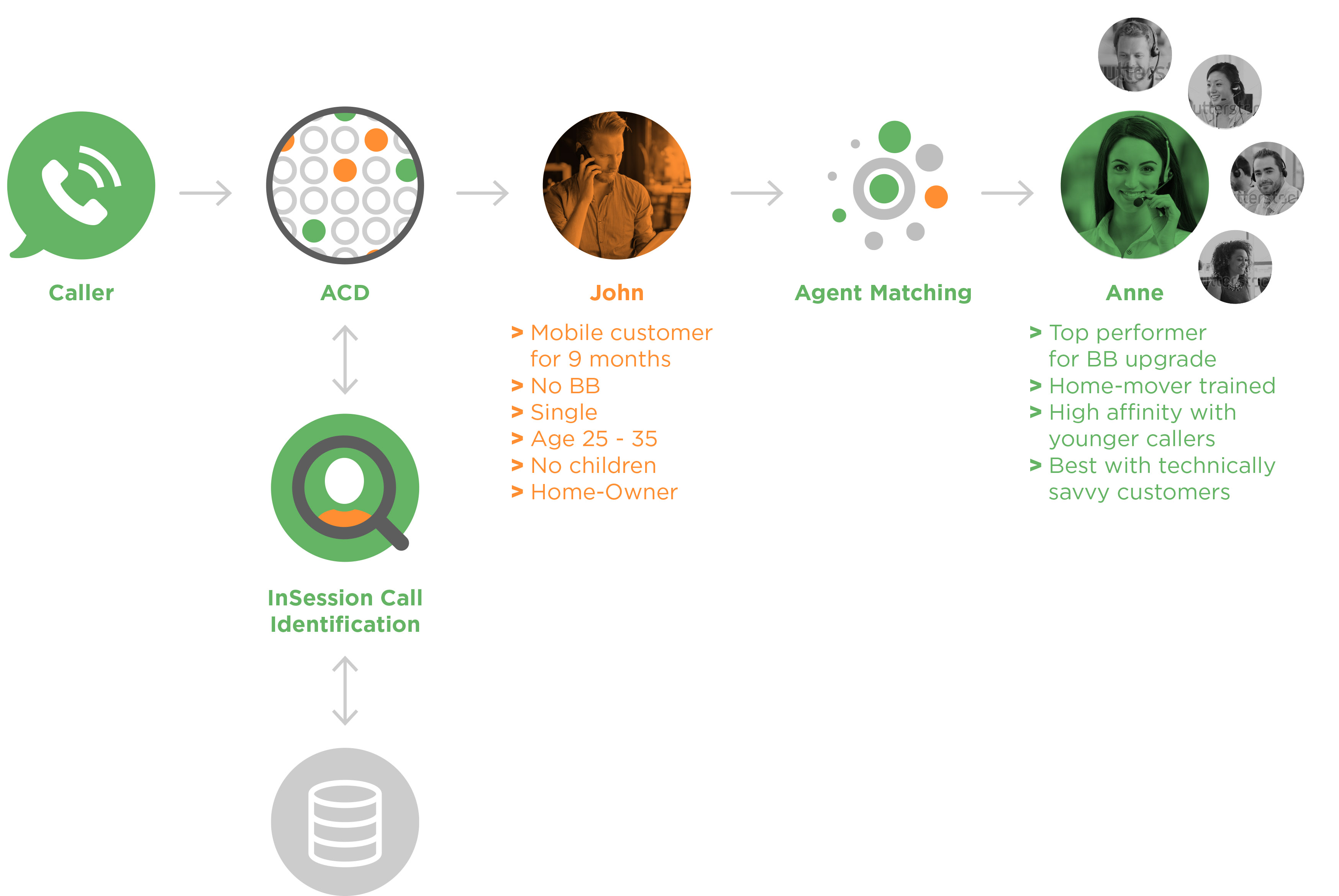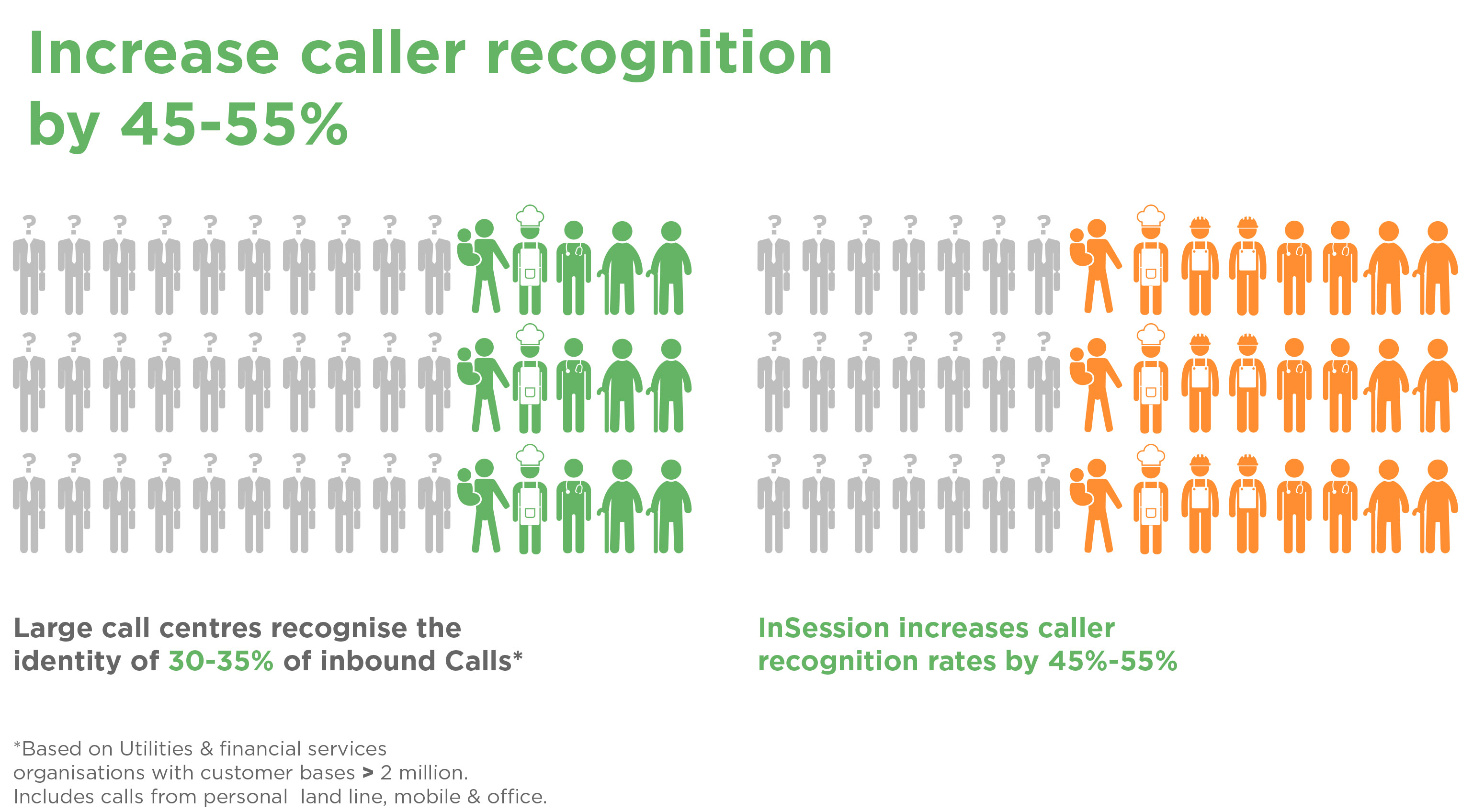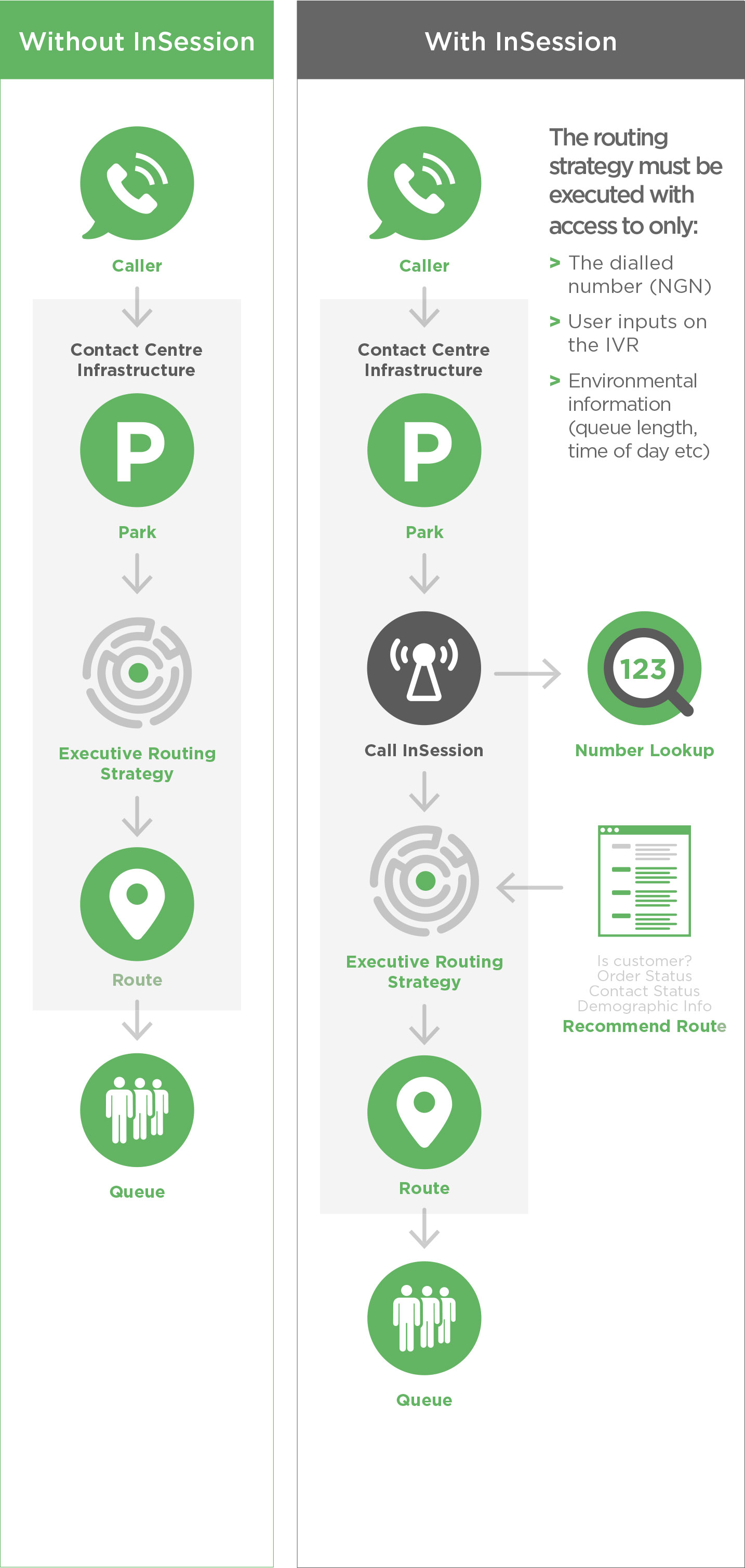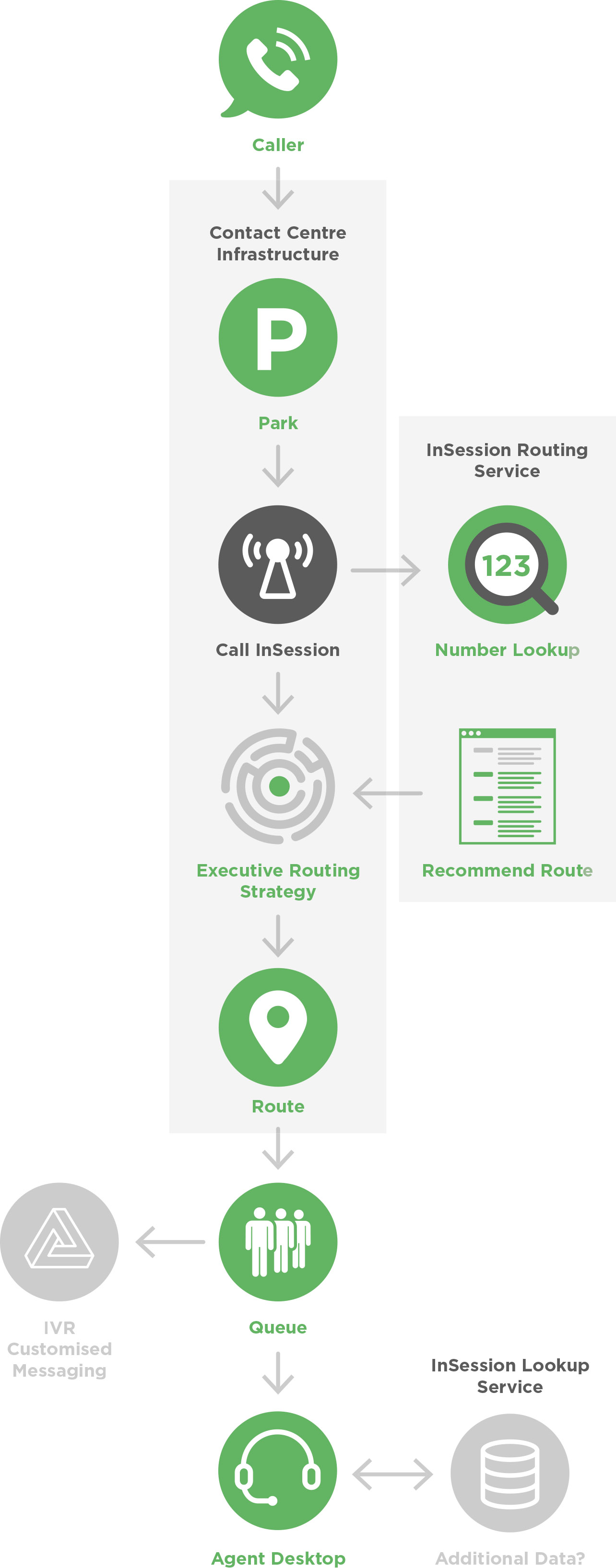InSession
Caller recognition is a necessary first step to intelligent, automated routing. By combining in-house and external data sources with simple API integration, firms can significantly increase call centre efficiency to the benefit of both the customer and contact centre.
Benefits
InSession helps organisations deliver cost reductions and revenue gains in the following areas:
> Reducing call transfers through increased levels of caller identification via its Knowledge based caller recognition functionality.
> Reducing implementation times for intelligent routing across internal and external data sources.
> Enhancing the ability to route calls to agents based on skills and performance.
> Increasing conversion rates and revenues through real-time recommendations as to which agent should be assigned to each caller.
> Supplying real-time external and internal data attributes to components of the telephony eco systems to inform and improve their decisioning. (IVR, Scripts, Agent desk tops, NBA, Voice recognition).
InSession can also be implemented as a “data-only” solution, where a consolidated up-to-date data knowledge base is made available to the call centre infrastructure to provide lookup services as part of a call routing strategy. InSession complements existing telephony platforms and does not require changes to existing technology infrastructure investments.

Supported Use-Cases
InSession provides the flexibility to support a variety of use cases. Key examples include:
InSession provides RESTful secure APIs which can be called during routing to provide real-time caller information.
C-Centric InSession provides 2 core services:
 InSession Routing – Advises route-point to call centre based on caller intelligence and defined business rules.
InSession Routing – Advises route-point to call centre based on caller intelligence and defined business rules.
 InSession Lookup – Supplementary caller information to inform decisioning and additional pop-up information at the agent desktop.
InSession Lookup – Supplementary caller information to inform decisioning and additional pop-up information at the agent desktop.
1. The business wants to identify attributes of the caller (i.e. whether they are existing customers, have open orders, are home-mover etc.), and have the call automatically directed to an appropriate contact centre call queue. In this case InSession can calculate a best route-point based on defined rules, or provide the data to the call centre application to make this decision.
2. The business wants to feed the contact centre with additional information to allow your existing contact centre infrastructure to make a more informed decision as to the best route for a call. In this case InSession can return additional information to the contact-centre system (customer attributes, contract dates, demographic data) to allow an intelligent routing decision to be made, data can be returned from the InSession knowledge based or using the InSession Lookup API.
3. The business wants to implement agent-based routing to route appropriate calls to the most effective agent. This is similar to use-case 2 above – but the information provided by InSession supplements the agent based skills-routing strategy to bring the caller to the best agent.
4. The business wants to integrate additional information about the caller at the agent desktop. The InSession Lookup API provides additional data from not yet integrated sources, or InSession can simply expose its knowledge base to the call centre pop-up APIs.

Background
In a typical SIP-based Contact Centre platform, in bound calls are received and parked at a SIP Route-Point. A routing strategy is then executed which determines routing based on the available information, namely:
 The dialled number (NGN).
The dialled number (NGN).
IVR menu choices made by the caller
 IVR inputs, where requested; for example the caller my be asked to key in an account number.
IVR inputs, where requested; for example the caller my be asked to key in an account number.
 Environmental factors such as time of day, queue availability and queue length.
Environmental factors such as time of day, queue availability and queue length.
Legacy approaches have focussed on the call centre queue as the central driver for call routing. That is: callers are placed in queues based on call type (the dialled number and IVR choices), the queue length and wait times. Increasingly call centre managers want to bring other factors into the routing equation. Call centre systems can now measure agent effectiveness and outcomes, allowing improvements in call handling to the benefit of the caller and the business.
Data is the fuel which drives this improvement in routing. InSession facilitates improvements in all routing strategies, providing caller recognition (even for non-customers) and additional information about the callers.
InSession can
> Calculate a route based on rules defined in the InSession system
> Provide additional information about a caller (allowing the call centre system to make all routing decisions)
> Support a hybrid approach: where InSession makes the initial routing decision and provides additional information to the call centre system to complete the rest of the routing strategy
Core Components
The InSession Knowledge Base – a knowledge base constructed from InSession data assets including a dataset of 28 million UK landline and mobile numbers, your own customer and order base, and optional additional demographic data provided by other UK data suppliers.
InSession Routing API – which addresses this issue by providing a universe of UK mobile and landline telephone numbers, which, when matched with client customer databases, results in a composite database of CLIs, which spans customers prospects and the CLIs from the InSession base.
Data associated with the caller (customer status, order status, contract end dates etc) allows InSession rules to be implemented for enhanced routing.
InSession Lookup API – which is designed to provide supplementary information to either power an intelligent IVR system or provide additional information to the agent desktop.
For example, by providing order status information the, intelligent IVR can be used to advise a caller of delivery dates, which may remove the need for live agent interaction.
Additional information at the agent desktop may assist the agent in providing an improved customer experience.
InSession analytics engine – this houses the algorithms and business rules that drive decisions for agent matching and call routing.
A key component of InSession is the ability to configure “1 in N” and time based control groups so that uplift from InSession strategies can be precisely measured.
Each project features a data integration phase where the client customer database is matched to the InSession repository. InSession includes technology to perform fuzzy matching (typically on name and address) between the client data and the InSession number Universe.
Routing Illustration
In the following example, we contrast routing with and without InSession Routing.

Lookup Illustration
In addition to the Routing endpoint, InSession provides an optional Lookup endpoint. This API provides additional information about the caller, which can be used either by an “Intelligent IVR” system – to provide bespoke messaging, IVR menus tailored to the user, or can be called from the agent desktop to provide additional caller information.
For example, if a caller is near end-of-contract, then the agent may be provided with information concerning the existing contract and products held. Clearly, where the caller has been identified (by the InSession routing API) – this information could also be accessed by integration with client CRM systems. However, InSession provides the capability to integrate data across multiple data-source across customer and prospects and multiple systems. As such, it offers a quicker route to market compared to rival solutions.
InSession Lookup provides additional information to support the Agent Desktop. InSession is a secure, cloud based service, utilizing simple, RESTful, JSON APIs – integration can be completed with a few hours of effort. Implementation timescales range from a few days to a few weeks depending on the number and complexity of the data sources. The InSession products include work-flow, matching capabilities and data.
Using InSession As A “Data-Only” Solution.
InSession can be implemented as a “Data-Only” solution.
In this scenario the InSession APIs are not utilised.
Instead, C-Centric can make available the InSession CLI universe, matching technology and, if required, additional 3rd party data sources to provide a rapid-deployment lookup data-source to fuel in-house callcentre solutions. In this scenario the client can utilise their own APIs to access a knowledge base provided by C-Centric using in-house developed APIs.

Summary of InSession™ Features
> InSession Knowledge DB
> Real-time analytics engine
> An integrated matching engine providing real-time fuzzy Name and Address matching capabilities
> RESTful APIs supporting number and data lookup
> Administrative web-portal
> Configurable routing rules
> Cloud based secure deployment
> Redundant architecture – load balanced web and
> application servers, clustered database option available
> HMAC based token authentication on each request
> Sub-second response times for routing,
> Lookup and matching
> Online API documentation
Next Steps
Arrange a meeting with one of our consultants, where a presentation will cover:
> Expected ROI based on your metrics
> How it will deploy alongside your telephony platform
> Options for a 90 day trial
> Time lines
- Product Overview
-
InSession can also be implemented as a “data-only” solution, where a consolidated up-to-date data knowledge base is made available to the call centre infrastructure to provide lookup services as part of a call routing strategy. InSession complements existing telephony platforms and does not require changes to existing technology infrastructure investments.

Supported Use-Cases
InSession provides the flexibility to support a variety of use cases. Key examples include:
InSession provides RESTful secure APIs which can be called during routing to provide real-time caller information.
C-Centric InSession provides 2 core services:
 InSession Routing – Advises route-point to call centre based on caller intelligence and defined business rules.
InSession Routing – Advises route-point to call centre based on caller intelligence and defined business rules. InSession Lookup – Supplementary caller information to inform decisioning and additional pop-up information at the agent desktop.
InSession Lookup – Supplementary caller information to inform decisioning and additional pop-up information at the agent desktop.1. The business wants to identify attributes of the caller (i.e. whether they are existing customers, have open orders, are home-mover etc.), and have the call automatically directed to an appropriate contact centre call queue. In this case InSession can calculate a best route-point based on defined rules, or provide the data to the call centre application to make this decision.
2. The business wants to feed the contact centre with additional information to allow your existing contact centre infrastructure to make a more informed decision as to the best route for a call. In this case InSession can return additional information to the contact-centre system (customer attributes, contract dates, demographic data) to allow an intelligent routing decision to be made, data can be returned from the InSession knowledge based or using the InSession Lookup API.
3. The business wants to implement agent-based routing to route appropriate calls to the most effective agent. This is similar to use-case 2 above – but the information provided by InSession supplements the agent based skills-routing strategy to bring the caller to the best agent.
4. The business wants to integrate additional information about the caller at the agent desktop. The InSession Lookup API provides additional data from not yet integrated sources, or InSession can simply expose its knowledge base to the call centre pop-up APIs.

Background
In a typical SIP-based Contact Centre platform, in bound calls are received and parked at a SIP Route-Point. A routing strategy is then executed which determines routing based on the available information, namely:
 The dialled number (NGN).
The dialled number (NGN).IVR menu choices made by the caller

 IVR inputs, where requested; for example the caller my be asked to key in an account number.
IVR inputs, where requested; for example the caller my be asked to key in an account number. Environmental factors such as time of day, queue availability and queue length.
Environmental factors such as time of day, queue availability and queue length.Legacy approaches have focussed on the call centre queue as the central driver for call routing. That is: callers are placed in queues based on call type (the dialled number and IVR choices), the queue length and wait times. Increasingly call centre managers want to bring other factors into the routing equation. Call centre systems can now measure agent effectiveness and outcomes, allowing improvements in call handling to the benefit of the caller and the business.
Data is the fuel which drives this improvement in routing. InSession facilitates improvements in all routing strategies, providing caller recognition (even for non-customers) and additional information about the callers.
InSession can
> Calculate a route based on rules defined in the InSession system
> Provide additional information about a caller (allowing the call centre system to make all routing decisions)
> Support a hybrid approach: where InSession makes the initial routing decision and provides additional information to the call centre system to complete the rest of the routing strategy
- Core Components
-
Core Components
The InSession Knowledge Base – a knowledge base constructed from InSession data assets including a dataset of 28 million UK landline and mobile numbers, your own customer and order base, and optional additional demographic data provided by other UK data suppliers.
InSession Routing API – which addresses this issue by providing a universe of UK mobile and landline telephone numbers, which, when matched with client customer databases, results in a composite database of CLIs, which spans customers prospects and the CLIs from the InSession base.
Data associated with the caller (customer status, order status, contract end dates etc) allows InSession rules to be implemented for enhanced routing.
InSession Lookup API – which is designed to provide supplementary information to either power an intelligent IVR system or provide additional information to the agent desktop.
For example, by providing order status information the, intelligent IVR can be used to advise a caller of delivery dates, which may remove the need for live agent interaction.
Additional information at the agent desktop may assist the agent in providing an improved customer experience.
InSession analytics engine – this houses the algorithms and business rules that drive decisions for agent matching and call routing.
A key component of InSession is the ability to configure “1 in N” and time based control groups so that uplift from InSession strategies can be precisely measured.
Each project features a data integration phase where the client customer database is matched to the InSession repository. InSession includes technology to perform fuzzy matching (typically on name and address) between the client data and the InSession number Universe.
Routing Illustration
In the following example, we contrast routing with and without InSession Routing.

Lookup Illustration
In addition to the Routing endpoint, InSession provides an optional Lookup endpoint. This API provides additional information about the caller, which can be used either by an “Intelligent IVR” system – to provide bespoke messaging, IVR menus tailored to the user, or can be called from the agent desktop to provide additional caller information.
For example, if a caller is near end-of-contract, then the agent may be provided with information concerning the existing contract and products held. Clearly, where the caller has been identified (by the InSession routing API) – this information could also be accessed by integration with client CRM systems. However, InSession provides the capability to integrate data across multiple data-source across customer and prospects and multiple systems. As such, it offers a quicker route to market compared to rival solutions.
InSession Lookup provides additional information to support the Agent Desktop. InSession is a secure, cloud based service, utilizing simple, RESTful, JSON APIs – integration can be completed with a few hours of effort. Implementation timescales range from a few days to a few weeks depending on the number and complexity of the data sources. The InSession products include work-flow, matching capabilities and data.
Using InSession As A “Data-Only” Solution.
InSession can be implemented as a “Data-Only” solution.
In this scenario the InSession APIs are not utilised.
Instead, C-Centric can make available the InSession CLI universe, matching technology and, if required, additional 3rd party data sources to provide a rapid-deployment lookup data-source to fuel in-house callcentre solutions. In this scenario the client can utilise their own APIs to access a knowledge base provided by C-Centric using in-house developed APIs.

- Summary
-
Summary of InSession™ Features
> InSession Knowledge DB
> Real-time analytics engine
> An integrated matching engine providing real-time fuzzy Name and Address matching capabilities
> RESTful APIs supporting number and data lookup
> Administrative web-portal
> Configurable routing rules
> Cloud based secure deployment
> Redundant architecture – load balanced web and
> application servers, clustered database option available
> HMAC based token authentication on each request
> Sub-second response times for routing,
> Lookup and matching
> Online API documentation
Next Steps
Arrange a meeting with one of our consultants, where a presentation will cover:
> Expected ROI based on your metrics
> How it will deploy alongside your telephony platform
> Options for a 90 day trial
> Time lines
Other solutions …

Revolutionary data insights to reduce customer churn and cross-sell more


 Customer Acquisition
Customer Acquisition